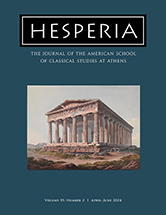Hesperia 93.2 Now Online!

We are pleased to announce the publication of Hesperia 93.2! Topics in this issue include an examination of the dating and design of the Hephaisteion in Athens, an overview of terracotta jointed dolls from Corinth, and a study that identifies the Boudroumi as a prison in Late Antique Corinth.
Subscribers can read the issue online at Project MUSE, which now hosts current issues of Hesperia as well as an archive of past volumes dating to 2002. Hesperia remains on JSTOR as part of their Arts and Sciences II package, with the usual three-year moving wall. Additionally, all issues of Hesperia from 2011 and earlier are available as Open Access on our website. The printed version will be mailed shortly.
The Hephaisteion in Athens: Its Date and Design, by Margaret M. Miles and Kathleen M. Lynch, examines the American excavations of the interior of the Hephaisteion and its surroundings, which were published in 1941. The authors reexamine the findings, the evidence for the foundations, the original notebooks, and the previously unpublished context pottery, and conclude that the Temple of Hephaistos and Athena was constructed in two stages: the foundations were laid ca. 480 BCE, and after a hiatus the superstructure was completed ca. 465–460 BCE, with repairs after the earthquake of 426 BCE. This article provides a new reconstruction of the interior space, finished without a colonnade, and with painted murals instead. The primary feature of the interior was the statue group, cult images of Athena and Hephaistos, made by Alkamenes of Lemnos and installed in 416/5 BCE.
Early Corinthian Jointed Dolls: Context, Meaning, and Diffusion, by Susan Langdon, brings focus to a subset of terracotta figurines from Corinth. Of the many innovations made by Corinthian coroplasts, the most distinctive may be the Classical-period jointed dolls. Scholarship connects the nude figures with the rituals of girls’ maturation and preparation for marriage. Largely overlooked are jointed dolls in chitoniskos and polos, presumed forerunners of the nudes. Over 40 specimens excavated at the Sanctuary of Demeter and Kore on Acrocorinth offer an opportunity to understand the development of dolls within their Corinthian religious and social setting. This investigation reveals a dozen Archaizing types and tracks their dissemination across the Greek-speaking world. Far from a brief prelude to Classical dolls, the early figurines bear witness to cult developments and previously undetected rituals in Corinth.
A Prison in Late Antique Corinth, by Matthew D. C. Larsen, aims to offer a secure identification of the “Boudroumi” and the Northwest Shops in the Roman Forum at ancient Corinth as a site of incarceration in the Late Antique period. The identification is made based on both prisoner graffiti from the 5th to 6th century CE inscribed on slabs and the notebooks from the Corinth Excavations in 1901, which clarify that the slabs were discovered in situ and served as floor pavement. The small finds excavated from beneath the level of the pavement are analyzed to establish a terminus post quem for the repurposing of the structures into a prison, as well as the architectural changes made. Further, the structures’ reuse is contextualized within the broader history of Corinth.
Click here to subscribe to Hesperia. In addition to receiving printed issues and online access to Hesperia, subscribers also receive complimentary online access to Hesperia Supplements, and Agora and Corinth volumes.
Hesperia welcomes submissions from scholars working on all aspects of Greek material culture, including archaeology, art, architecture, history, epigraphy, and related studies. Further information about the journal, including instructions for preparing manuscripts for submission, can be found on our website.
The Friends of Hesperia was founded in 2014 to help fund the journal's growth in all its manifestations. We invite you to become a member today and help support one of the most preeminent journals in the field of Mediterranean archaeology.